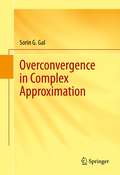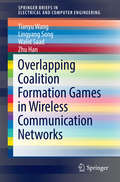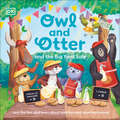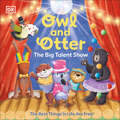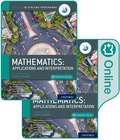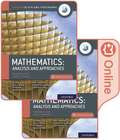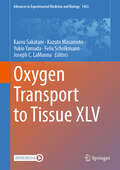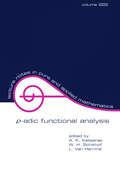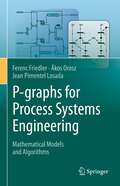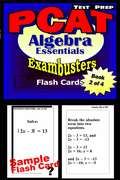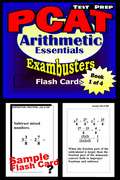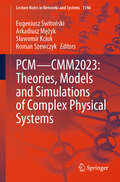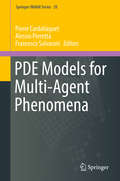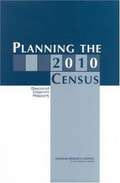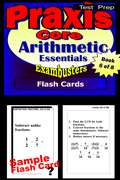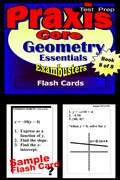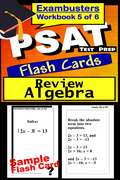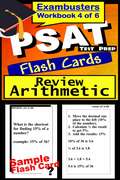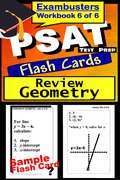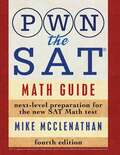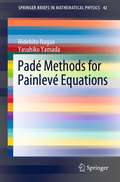- Table View
- List View
Overconvergence in Complex Approximation
by Sorin G. GalThis monograph deals with the quantitative overconvergence phenomenon in complex approximation by various operators. The book is divided into three chapters. First, the results for the Schurer-Faber operator, Beta operators of first kind, Bernstein-Durrmeyer-type operators and Lorentz operator are presented. The main focus is on results for several q-Bernstein kind of operators with q > 1, when the geometric order of approximation 1/qn is obtained not only in complex compact disks but also in quaternion compact disks and in other compact subsets of the complex plane. The focus then shifts to quantitative overconvergence and convolution overconvergence results for the complex potentials generated by the Beta and Gamma Euler's functions. Finally quantitative overconvergence results for the most classical orthogonal expansions (of Chebyshev, Legendre, Hermite, Laguerre and Gegenbauer kinds) attached to vector-valued functions are presented. Each chapter concludes with a notes and open problems section, thus providing stimulation for further research. An extensive bibliography and index complete the text. This book is suitable for researchers and graduate students working in complex approximation and its applications, mathematical analysis and numerical analysis.
Overlapping Coalition Formation Games in Wireless Communication Networks
by Zhu Han Walid Saad Tianyu Wang Lingyang SongThis brief introduces overlapping coalition formation games (OCF games), a novel mathematical framework from cooperative game theory that can be used to model, design and analyze cooperative scenarios in future wireless communication networks. The concepts of OCF games are explained, and several algorithmic aspects are studied. In addition, several major application scenarios are discussed. These applications are drawn from a variety of fields that include radio resource allocation in dense wireless networks, cooperative spectrum sensing for cognitive radio networks, and resource management for crowd sourcing. For each application, the use of OCF games is discussed in detail in order to show how this framework can be used to solve relevant wireless networking problems. Overlapping Coalition Formation Games in Wireless Communication Networks provides researchers, students and practitioners with a concise overview of existing works in this emerging area, exploring the relevant fundamental theories, key techniques, and significant applications.
Owl and Otter and the Big Yard Sale: Join in the Fun, and Learn About Addition and Counting Money!
by DKJoin Owl and Otter as they have fun selling homemade treats, teaching children math skills and money.Mini mathematicians will love following this funny, sweet-filled adventure that gently introduces them to simple addition and money skills.Owl, Otter, and their friends are so excited to start selling their delicious cookies and bottles of lemonade. Everything is off to a great start until the friends begin muddling up how much customers need to pay. With more and more customers waiting and lots of numbers to add up, one disaster leads to another! But never fear - teamwork and Otter&’s wiggly toes save the day…This exciting early learning book for kids offers:- A humorous, action-packed storyline combined with early-learning information about addition and counting money.- An introduction for kids to earning and saving money from an early age.- Illustrated characters that bring a playful element to learning about the topic of math and basic addition. With a helpful glossary covering everything from what terms such as supply and demand mean, to earning and saving money, Owl and Otter and the Big Yard Sale shows that you&’re never too young or furry to learn about money. So, what are you waiting for? Let's go and sell some lemonade and cookies!
Owl and Otter: The Best Things In Life Are Free!
by DKJoin Owl, Otter, and their friends on their next adventure—The Big Talent Show—in this entertaining story that builds children's math skills and teaches them about money.Owl, Otter, and their friends are back, and this time they’re holding an epic talent show! It’s free to perform, but $2 to watch. With lots of woodland friends coming to support them, Owl and Otter will need to draw on their addition and subtraction skills to make sure everyone gets their change, and more importantly, their tickets, before the show begins!Mini mathematicians will love following this dazzling adventure that gently introduces them to simple addition and subtraction skills. With a helpful glossary covering everything they’ve learned, this charming book shows that you're never too young or too furry to learn about money, saving, and the importance of friendship.So, what are you waiting for? Let's dive in and discover some hidden talents!
Oxford IB Diploma Programme Ib Mathematics: Applications And Interpretation, Standard Level
by David Harris Jane Forrest Nadia Stoyanova Kennedy Paula Waldman Suzanne Doering Jennifer Chang WathallFeaturing a wealth of digital content, this concept-based Print and Enhanced Online Course Book Pack has been developed in cooperation with the IB to provide the most comprehensive support for the new DP Mathematics: applications and interpretation SL syllabus, for first teaching in September 2019. Each Enhanced Online Course Book Pack is made up of one full-colour, print textbook and one online textbook - packed full of investigations, exercises, worksheets, worked solutions and answers, plus assessment preparation support.
Oxford Ib Diploma Programme Ib Mathematics: Analysis And Approaches, Standard Level, Print And Enhanced Online Course Book Pack
by Ellen Thompson Ed Kemp Laurie Buchanan Jill Stevens Natasha Awada Jennifer Chang Wathall Paul La RondieFeaturing a wealth of digital content, this concept-based Print and Enhanced Online Course Book Pack has been developed in cooperation with the IB to provide the most comprehensive support for the new DP Mathematics: analysis and approaches SL syllabus, for first teaching in September 2019.
Oxygen Transport to Tissue XLV (Advances in Experimental Medicine and Biology #1463)
by Joseph C. LaManna Felix Scholkmann Kaoru Sakatani Kazuto Masamoto Yukio YamadaThis book presents cutting-edge papers and perspectives on the transport of oxygen to tissues by scientists in a multitude of disciplines such as biochemistry, engineering, mathematics, medicine, physics, physiology, veterinary and complementary medicine. The book is composed of the following 7 parts: 50th Anniversary, Brain, Clinical applications, Methods and techniques, Tumor Oxygenation, Tissue oxygenation and Muscle. The articles in this book have been presented at the 50th annual meeting of the International Society on Oxygen Transport to Tissue (ISOTT 2023). Academics, clinical and industry researchers, engineers, as well as graduate students who are interested in oxygen transport to tissue will find this book a great reference and a useful learning resource.
P-Adic Functional Analysis
by A. K. Kstsaras W. H. Schikhof L. Van HammeThis volume collects together lectures presented at the Sixth International Conference held at the University of Ioannina, Greece, on p-adic functional analysis with applications in the fields of physics, differential equations, number theory, probability theory, dynamical systems, and algebraic number fields. It discusses the commutation relation AB-BA=I and its central role in quantum mechanics.
P-graphs for Process Systems Engineering: Mathematical Models and Algorithms
by Ferenc Friedler Ákos Orosz Jean Pimentel LosadaThis book discusses the P-graph framework for developing and understanding effective design tools for process systems engineering, and addresses the current state of its theory and applications. The book details the new philosophy of the axioms-based mathematical modelling of processing systems, the basic algorithms, areas of application, future directions, and the proofs of theorems and algorithms. Because of the rigorous foundation of the theory, the framework provides a firm basis for future research in mathematical modelling, optimization, and design of complex engineering systems. The various P-graph applications discussed include process network synthesis, reliability engineering, and systems resilience. The framework opens new avenues for research in complex systems including redundant operations for critical infrastructure, systems sustainability, and modelling tools for disaster engineering. Demonstration software is provided to facilitate the understanding of the theory. The book will be of interest to institutions, companies, and individuals performing research and R&D in process systems engineering.
PCAT Test Prep Flash Cards: Algebra Essentials (Exambusters PCAT Workbook #2 of 4)
by Ace Inc.<P><P><i>Advisory: Bookshare has learned that this book offers only partial accessibility. We have kept it in the collection because it is useful for some of our members. Benetech is actively working on projects to improve accessibility issues such as these.</i><P><P> 450 questions and answers that highlight introductory algebra definitions, problems, and concepts.<P><P> Topics: Algebraic Concepts, Sets, Variables, Exponents, Properties of Numbers, Simple Equations, Signed Numbers, Monomials, Polynomials, Additive and Multiplicative Inverse, Word Problems, Prime Numbers, Factoring, Algebraic Fractions, Ratio and Proportion, Variation, Radicals, Quadratic Equations <P>Exambusters PCAT Prep Workbooks provide comprehensive, fundamental PCAT review--one fact at a time--to prepare students to take practice PCAT tests. Each PCAT study guide focuses on one specific subject area covered on the PCAT exams. From 300 to 600 questions and answers, each volume in the PCAT series is a quick and easy, focused read. Reviewing PCAT flash cards is the first step toward more confident PCAT preparation and ultimately, higher PCAT exam scores!
PCAT Test Prep Flash Cards: Arithmetic Essentials (Exambusters PCAT Workbook #1 of 4)
by Ace Inc.<P><P><i>Advisory: Bookshare has learned that this book offers only partial accessibility. We have kept it in the collection because it is useful for some of our members. Benetech is actively working on projects to improve accessibility issues such as these.</i><P><P> 600 questions and answers highlight essential arithmetic definitions, problems, and concepts. <P><P>Topics: Addition, Subtraction, Multiplication, and Division of Whole Numbers; Fractions and Decimals, Multiplication Tables, Word Problems, Percents, Measurement, Metric System, Square Roots and Powers, Real Numbers, Properties of Numbers<P>Exambusters PCAT Prep Workbooks provide comprehensive, fundamental PCAT review--one fact at a time--to prepare students to take practice PCAT tests. Each PCAT study guide focuses on one specific subject area covered on the PCAT exams. From 300 to 600 questions and answers, each volume in the PCAT series is a quick and easy, focused read. Reviewing PCAT flash cards is the first step toward more confident PCAT preparation and ultimately, higher PCAT exam scores!
PCM—CMM2023: Theories, Models and Simulations of Complex Physical Systems (Lecture Notes in Networks and Systems #1146)
by Roman Szewczyk Sławomir Kciuk Arkadiusz Mężyk Eugeniusz ŚwitońskiThe idea of organizing the Polish Congress of Mechanics was born in 2005 among members of the Polish Society of Theoretical and Applied Mechanics. The first Congress has been organized in 2007. In 2013, the organization of the Polish Congress of Mechanics was included in the statutory tasks of the Polish Society of Theoretical and Applied Mechanics. Referring to the splendid tradition of Polish Theoretical and Applied Mechanics, the Congress has become one of the most important international scientific conventions representing this domain of science and gathering every 4 years about 500–600 specialists, who deal with the issues of mechanics and mechanical engineering in a broad sense. The organization of the Congress allows for the connection of many scientific communities, researchers, and engineers from various universities, faculties, research centers, and institutions. Such scientific meeting is an excellent place for presentation, discussion, and dissemination of new achievements and ideas relating to the theoretical foundations as well as practical applications of mechanics. The Congress presents the current state-of-the-art research in all disciplines of classical and quantum mechanics, solid and fluid mechanics, computational mechanics, applied mechanics, and physics, as well as structural mechanics and engineering.
PDE Models for Multi-Agent Phenomena (Springer INdAM Series #28)
by Pierre Cardaliaguet Alessio Porretta Francesco SalvaraniThis volume covers selected topics addressed and discussed during the workshop “PDE models for multi-agent phenomena,” which was held in Rome, Italy, from November 28th to December 2nd, 2016. The content mainly focuses on kinetic equations and mean field games, which provide a solid framework for the description of multi-agent phenomena. The book includes original contributions on the theoretical and numerical study of the MFG system: the uniqueness issue and finite difference methods for the MFG system, MFG with state constraints, and application of MFG to market competition. The book also presents new contributions on the analysis and numerical approximation of the Fokker-Planck-Kolmogorov equations, the isotropic Landau model, the dynamical approach to the quantization problem and the asymptotic methods for fully nonlinear elliptic equations. Chiefly intended for researchers interested in the mathematical modeling of collective phenomena, the book provides an essential overview of recent advances in the field and outlines future research directions.
PICTURING QUANTUM PROCESSES: A First Course in Quantum Theory and Diagrammatic Reasoning
by Bob Coecke Aleks KissingerThe unique features of the quantum world are explained in this book through the language of diagrams, setting out an innovative visual method for presenting complex theories. Requiring only basic mathematical literacy, this book employs a unique formalism that builds an intuitive understanding of quantum features while eliminating the need for complex calculations. This entirely diagrammatic presentation of quantum theory represents the culmination of ten years of research, uniting classical techniques in linear algebra and Hilbert spaces with cutting-edge developments in quantum computation and foundations. Written in an entertaining and user-friendly style and including more than one hundred exercises, this book is an ideal first course in quantum theory, foundations, and computation for students from undergraduate to PhD level, as well as an opportunity for researchers from a broad range of fields, from physics to biology, linguistics, and cognitive science, to discover a new set of tools for studying processes and interaction.
PLANNING THE 2010 CENSUS: Second Interim Report
by Panel on Research on Future Census MethodsA report on Planning the 2010 Census
PRAXIS Core Test Prep Flash Cards: Algebra (Exambusters PRAXIS Core Workbook #7 of 8)
by Ace Inc.<P><P><i>Advisory: Bookshare has learned that this book offers only partial accessibility. We have kept it in the collection because it is useful for some of our members. Benetech is actively working on projects to improve accessibility issues such as these.</i><P><P> 450 questions and answers that highlight introductory algebra definitions, problems, and concepts. <P><P>Topics: Algebraic Concepts, Sets, Variables, Exponents, Properties of Numbers, Simple Equations, Signed Numbers, Monomials, Polynomials, Additive and Multiplicative Inverse, Word Problems, Prime Numbers, Factoring, Algebraic Fractions, Ratio and Proportion, Variation, Radicals, Quadratic Equations <P>EXAMBUSTERS PRAXIS Prep Workbooks provide comprehensive, fundamental PRAXIS review--one fact at a time--to prepare students to take practice PRAXIS tests. Each PRAXIS study guide focuses on one specific subject area covered on the PRAXIS exam. From 300 to 600 questions and answers, each volume in the PRAXIS series is a quick and easy, focused read. Reviewing PRAXIS flash cards is the first step toward more confident PRAXIS preparation and ultimately, higher PRAXIS exam scores!
PRAXIS Core Test Prep Flash Cards: Arithmetic (Exambusters PRAXIS Core Workbook #6 of 8)
by Ace Inc.<P><P><i>Advisory: Bookshare has learned that this book offers only partial accessibility. We have kept it in the collection because it is useful for some of our members. Benetech is actively working on projects to improve accessibility issues such as these.</i><P><P> 600 questions and answers highlight essential arithmetic definitions, problems, and concepts. <P><P>Topics: Addition, Subtraction, Multiplication, and Division of Whole Numbers; Fractions and Decimals, Multiplication Tables, Word Problems, Percents, Measurement, Metric System, Square Roots and Powers, Real Numbers, Properties of Numbers <P>EXAMBUSTERS PRAXIS Prep Workbooks provide comprehensive, fundamental PRAXIS review--one fact at a time--to prepare students to take practice PRAXIS tests. Each PRAXIS study guide focuses on one specific subject area covered on the PRAXIS exam. From 300 to 600 questions and answers, each volume in the PRAXIS series is a quick and easy, focused read. Reviewing PRAXIS flash cards is the first step toward more confident PRAXIS preparation and ultimately, higher PRAXIS exam scores!
PRAXIS Core Test Prep Flash Cards: Geometry (Exambusters PRAXIS Core Workbook #8 of 8)
by Ace Inc.<P><P><i>Advisory: Bookshare has learned that this book offers only partial accessibility. We have kept it in the collection because it is useful for some of our members. Benetech is actively working on projects to improve accessibility issues such as these.</i><P><P> 450 questions and answers that focus on essential geometry theorems, postulates, concepts, and definitions. Includes complementary diagrams.<P><P> Topics: Lines and Angles, Triangles, Proofs, Perpendicular Lines, Parallel Lines, Angle Sums, Quadrilaterals, Medians, Altitudes and Bisectors, Circles, Ratio and Proportion, Similar Polygons, Circles and Regular Polygons, Coordinate Geometry <P>EXAMBUSTERS PRAXIS Prep Workbooks provide comprehensive, fundamental PRAXIS review--one fact at a time--to prepare students to take practice PRAXIS tests. Each PRAXIS study guide focuses on one specific subject area covered on the PRAXIS exam. From 300 to 600 questions and answers, each volume in the PRAXIS series is a quick and easy, focused read. Reviewing PRAXIS flash cards is the first step toward more confident PRAXIS preparation and ultimately, higher PRAXIS exam scores!
PSAT Test Prep Flash Card Review: Algebra Review (Exambusters PSAT Workbook #5 of 6)
by Ace Inc.<P><P><i>Advisory: Bookshare has learned that this book offers only partial accessibility. We have kept it in the collection because it is useful for some of our members. Benetech is actively working on projects to improve accessibility issues such as these.</i><P><P> 450 questions and answers that highlight introductory algebra definitions, problems, and concepts. <P><P>Topics: Algebraic Concepts, Sets, Variables, Exponents, Properties of Numbers, Simple Equations, Signed Numbers, Monomials, Polynomials, Additive and Multiplicative Inverse, Word Problems, Prime Numbers, Factoring, Algebraic Fractions, Ratio and Proportion, Variation, Radicals, Quadratic Equations <P>EXAMBUSTERS PSAT Prep Workbooks provide comprehensive, fundamental PSAT review--one fact at a time--to prepare students to take practice PSAT tests. Each PSAT study guide focuses on one specific subject area covered on the PSAT exam. From 300 to 600 questions and answers, each volume in the PSAT series is a quick and easy, focused read. Reviewing PSAT flash cards is the first step toward more confident PSAT preparation and ultimately, higher PSAT exam scores!
PSAT Test Prep Flash Cards: Arithmetic Review (Exambusters PSAT Workbook #4 of 6)
by Ace Inc.<P><P><i>Advisory: Bookshare has learned that this book offers only partial accessibility. We have kept it in the collection because it is useful for some of our members. Benetech is actively working on projects to improve accessibility issues such as these.</i><P><P> 600 questions and answers highlight essential arithmetic definitions, problems, and concepts.<P><P> Topics: Addition, Subtraction, Multiplication, and Division of Whole Numbers; Fractions and Decimals, Multiplication Tables, Word Problems, Percents, Measurement, Metric System, Square Roots and Powers, Real Numbers, Properties of Numbers <P>EXAMBUSTERS PSAT Prep Workbooks provide comprehensive, fundamental PSAT review--one fact at a time--to prepare students to take practice PSAT tests. Each PSAT study guide focuses on one specific subject area covered on the PSAT exam. From 300 to 600 questions and answers, each volume in the PSAT series is a quick and easy, focused read. Reviewing PSAT flash cards is the first step toward more confident PSAT preparation and ultimately, higher PSAT exam scores!
PSAT Test Prep Flash Cards: Geometry Review (Exambusters PSAT Workbook #6 of 6)
by Ace Inc.<P><P><i>Advisory: Bookshare has learned that this book offers only partial accessibility. We have kept it in the collection because it is useful for some of our members. Benetech is actively working on projects to improve accessibility issues such as these.</i><P><P> 450 questions and answers that focus on essential geometry theorems, postulates, concepts, and definitions. Includes complementary diagrams. <P><P>Topics: Lines and Angles, Triangles, Proofs, Perpendicular Lines, Parallel Lines, Angle Sums, Quadrilaterals, Medians, Altitudes and Bisectors, Circles, Ratio and Proportion, Similar Polygons, Circles and Regular Polygons, Coordinate Geometry <P>EXAMBUSTERS PSAT Prep Workbooks provide comprehensive, fundamental PSAT review--one fact at a time--to prepare students to take practice PSAT tests. Each PSAT study guide focuses on one specific subject area covered on the PSAT exam. From 300 to 600 questions and answers, each volume in the PSAT series is a quick and easy, focused read. Reviewing PSAT flash cards is the first step toward more confident PSAT preparation and ultimately, higher PSAT exam scores!
PWN the SAT Math Guide
by Mike McClenathanThe PWN the SAT Math Guide was created to help ambitious, highly motivated kids maximize their SAT math scores. Do you crave a higher score? Are you willing to do a little hard work to achieve it? Good. I knew I liked you. Read this book from beginning to end, with a pencil in hand and a calculator and an Official SAT Study Guide by your side. When you’re done, you’ll be able to approach the SAT with confidence—very few questions will surprise you, and even fewer will be able to withstand your withering attacks. <p><p> Stand tall, intrepid student. Destiny awaits. <p><p> Updated for the New SAT <p> This new edition of the Math Guide has been updated, rather painstakingly, to reflect the realities of the new SAT that launched in March 2016. This book was not rushed to market to take advantage of interest in the new exam. I took my time, and hopefully I got it right. <p><p> Chapters are broken into five major sections: Techniques, Heart of Algebra, Passport to Advanced Math, Problem Solving and Data Analysis, and Additional Topics in Math. Each chapter concludes with a reference list of similar questions from official practice tests. Practice questions are designated as either “Calculator” or “No calculator.” Students will be forbidden from using their calculators for one whole section of the new SAT. Emphasis is placed on nimbleness—the ability to approach problems in multiple ways to find the one that works best. Calculator solutions and shortcuts are provided where appropriate.
Padé Methods for Painlevé Equations (SpringerBriefs in Mathematical Physics #42)
by Yasuhiko Yamada Hidehito NagaoThe isomonodromic deformation equations such as the Painlevé and Garnier systems are an important class of nonlinear differential equations in mathematics and mathematical physics. For discrete analogs of these equations in particular, much progress has been made in recent decades. Various approaches to such isomonodromic equations are known: the Painlevé test/Painlevé property, reduction of integrable hierarchy, the Lax formulation, algebro-geometric methods, and others. Among them, the Padé method explained in this book provides a simple approach to those equations in both continuous and discrete cases.For a given function f(x), the Padé approximation/interpolation supplies the rational functions P(x), Q(x) as approximants such as f(x)~P(x)/Q(x). The basic idea of the Padé method is to consider the linear differential (or difference) equations satisfied by P(x) and f(x)Q(x). In choosing the suitable approximation problem, the linear differential equations give the Lax pair for some isomonodromic equations. Although this relation between the isomonodromic equations and Padé approximations has been known classically, a systematic study including discrete cases has been conducted only recently. By this simple and easy procedure, one can simultaneously obtain various results such as the nonlinear evolution equation, its Lax pair, and their special solutions. In this way, the method is a convenient means of approaching the isomonodromic deformation equations.
